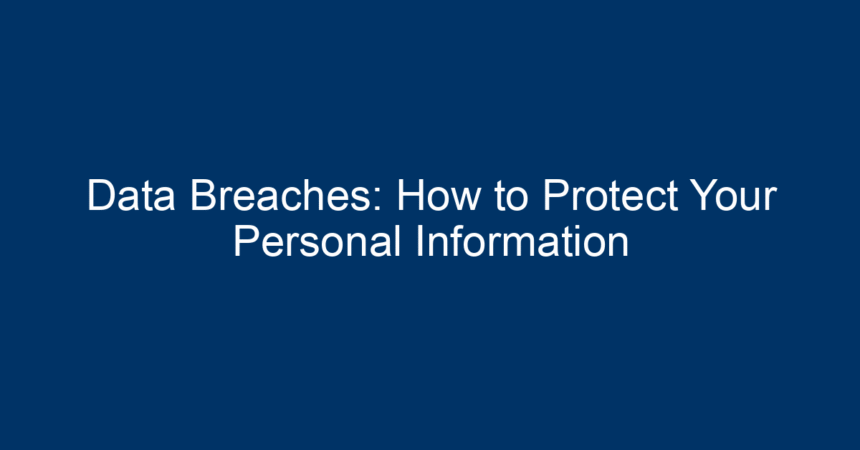In an era where our lives are increasingly digital, the threat of data breaches is looming larger than ever. From social media accounts to online banking, sensitive personal information is stored everywhere, making it a prime target for cybercriminals. According to a report by Cybersecurity Ventures, damages related to data breaches are projected to reach $6 trillion annually by 2021. This staggering figure highlights the urgent need for individuals and organizations to safeguard personal information diligently.
In this article, we will explore what data breaches are, the types of sensitive information at risk, the potential consequences of such breaches, and effective strategies to protect your personal data. With the right knowledge and tools, you can significantly reduce the risk of becoming a victim of a data breach.
Understanding Data Breaches
What is a Data Breach?
A data breach occurs when unauthorized individuals gain access to sensitive information, typically stored electronically. This can range from customer names and email addresses to social security numbers and financial information. The breach can result from various factors, including malware attacks, phishing, insider threats, and even accidental leaks.
Types of Data Breaches
- Hacking: Cybercriminals infiltrate a system or network to steal sensitive data.
- Phishing: Deceptive emails or websites trick users into revealing personal information.
- Malware: Malicious software designed to infiltrate and damage systems and networks.
- Physical Breaches: Theft of devices containing sensitive data, such as laptops or hard drives.
- Human Error: Accidental data leaks resulting from negligence or unintentional oversights.
Common Targets of Data Breaches
Certain industries handle more sensitive data and are often targeted more than others. Common areas include:
- Healthcare: Personal health information (PHI) is prized by cybercriminals.
- Finance: Credit card numbers, bank account information, and social security numbers are lucrative targets.
- Retail: Customer data, including payment information, is often stored and can be stolen during hacking incidents.
Consequences of Data Breaches
The impact of a data breach can be devastating. Here are some of the potential consequences that individuals and organizations may face:
Financial Loss
Victims of data breaches can experience significant financial loss, either through identity theft or loss of funds. In many cases, recovering stolen money can be a long and arduous process.
Identity Theft
Data breaches can lead to identity theft, where perpetrators use stolen information to impersonate victims, open new accounts, and commit fraud.
Reputational Damage
Organizations that suffer a data breach may face a loss of trust from customers and clients, resulting in reputational damage that is often difficult to recover from.
Regulatory Penalties
Depending on the industry and region, businesses may face hefty fines and penalties for failing to protect consumer data adequately.
How to Protect Your Personal Information
1. Stay Informed
Knowledge is your first line of defense. Stay updated on the latest data breaches and cybersecurity trends. Websites like Have I Been Pwned can inform you if your email or passwords have been compromised in a known data breach.
2. Create Strong, Unique Passwords
Creating strong and unique passwords is crucial. Here are some tips for effective password management:
- Use a combination of letters, numbers, and special characters.
- Avoid easily guessed information, such as birthdays or family names.
- Consider using passphrases—longer phrases that are easy for you and hard for others to guess.
3. Enable Two-Factor Authentication (2FA)
Two-factor authentication adds an extra layer of security. With 2FA enabled, you need to provide two forms of identification before logging into your account, typically your password and a one-time code sent to your phone or email.
4. Be Cautious with Personal Information
Think carefully about the information you share online. Limit personal information on social media platforms and be wary of sharing sensitive details in public forums or unsecured websites.
5. Use a Password Manager
A password manager can help generate and store complex passwords securely. This prevents the temptation to reuse passwords, which is a common security flaw.
6. Regularly Monitor Your Accounts
Keeping an eye on your financial and online accounts can help catch unauthorized transactions or activities early. Set up alerts for unexpected transactions and check your credit report regularly for signs of identity theft.
7. Update Your Software Regularly
Outdated software can be a vulnerability that cybercriminals exploit. Ensure your operating systems, applications, and antivirus software are up to date to protect against the latest threats.
8. Secure Your Wi-Fi Network
Your home Wi-Fi network can be an access point for hackers. Use a strong password, enable encryption, and regularly change your router’s password to prevent unauthorized access.
9. Backup Your Data
Regularly backing up your data is a safeguard against data loss, should a breach occur. Use external hard drives or cloud-based services to keep copies of your important files.
10. Educate Yourself About Phishing
Recognize the signs of phishing attacks. Be cautious with unsolicited emails, especially those asking for personal information or containing suspicious links. Verify the sender’s identity before engaging with any content.
Conclusion: Actions You Can Take Now
Data breaches pose a significant threat in our interconnected world. However, by taking proactive measures, you can greatly reduce your risk of personal information being compromised. Stay informed, use strong passwords, enable two-factor authentication, and monitor your accounts regularly.
Being vigilant is key. Knowledge and good habits are your best defenses against cybercriminals. As technology continues to evolve, staying one step ahead with cybersecurity practices will empower you to protect your personal information effectively.
By arming yourself with the right strategies, you can navigate the digital landscape more securely and confidently, ensuring your personal information remains private and protected. Start implementing these actionable insights today to safeguard against data breaches!




